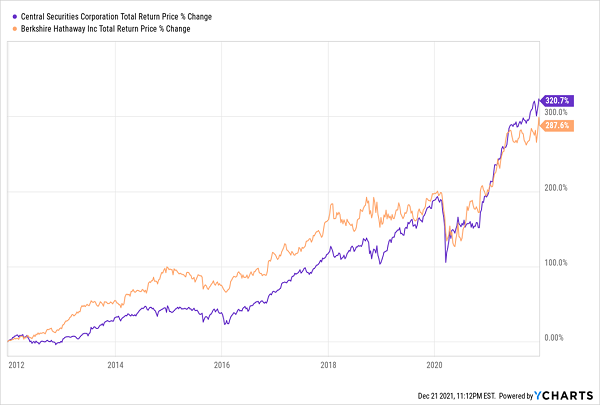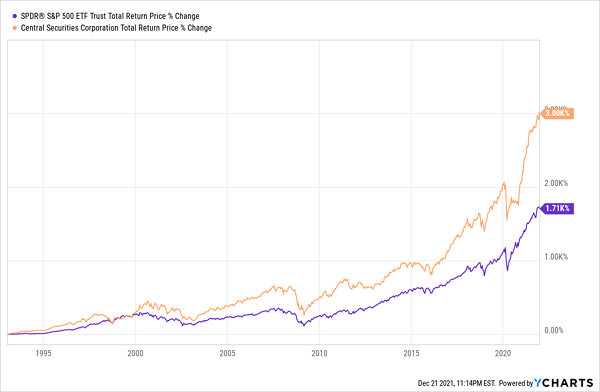Imagine a fund that’s beaten the Oracle of Omaha himself, Warren Buffett, for years and, unlike Berkshire Hathaway (BRK.A), pays a whopping 9% dividend!
Little-Known CEF Outruns the Best

As you can see in the chart above, the fund in question here is a closed-end fund (CEF) called Central Securities Corporation (CET). It’s got two things in common with Buffett himself: a focus on value and a long history—even longer than Buffett’s! CET traces its roots all the way back to 1929. In fact, the fund was founded on October 1 of that year, just 28 days before the Black Friday crash that triggered the Great Depression!
So this fund is no flash in the pan—Central Securities has weathered it all: wars, inflation, deflation, you name it.
Thanks in part to its long institutional memory, CET easily outran the S&P 500 during the challenging year that was 2021, too, keeping well ahead even as the broader market soared. As is its policy, it then turned around and handed the huge gains generated by its portfolio to investors in the form of a huge $2.68-a-share special dividend that just dropped into their accounts last week.
93-Year-Old Fund Still Has Legs in 2021

A Proven History of Tracking Down Deals
CET also shares Buffett’s penchant for large cap stocks, getting you exposure to great companies like Alphabet (GOOGL), Motorola (MSI), Charles Schwab (SCHW) and Buffett favorite American Express (EXP).
There’s no secret to CET’s strategy: it simply aims to own bargain-priced companies that are growing. In a recent Wall Street Journal interview, Wilmot H. Kidd, the fund’s CEO, who at 80 is something of a Buffett contemporary, laid it out in the simplest of terms: “We want to own growing companies during as much of their period of growth as we can,” he said.
That mantra has paid off handsomely for CET’s investors over the last 30 years.
Far Ahead of the Market

Thanks to the power of compounding returns, CET has returned nearly double what a low-cost index fund has over that timeframe, meaning an investor who put just $10,000 in the fund back then and invested nothing else now has $300,000. And, shockingly, that would now be enough to retire on.
A Long Line of Special Payouts

Thanks to CET’s mandate to hand out big special dividends at the end of the year, with $300,000 in the fund you’d get $2,250 in monthly income, on average, if you broke its latest special dividend out over 12 months. That means someone living in a low-cost area of the US could feasibly retire thanks to a meager $10,000 investment made 30 years ago!
While financial advisors like to tell us that very few people are capable of beating the market and that our best move is to put our money in low-cost index funds, that is simply false, and CET proves it. While CET gets you $2,250 per month on 300K, that same amount of income would require a whopping $1.5 million in an index fund that tracks the S&P 500, even though many of CET’s holdings are themselves S&P 500 companies.
This is possible thanks to the fund’s active management. The way a fund like CET (and many other CEFs like it) works is that it routinely takes profits, rotates investments and buys and sells its holdings at times that are best for the fund’s overall return. When it cashes out its holdings, it then returns the profits to shareholders in the form of a cash dividend.
That makes it a lot easier to actually retire on less money than you’d ever be able to with a popular index fund like the SPDR S&P 500 ETF Trust (SPY), which you would need to actively sell shares of to realize more than the meager 1.2% yield it pays out. (And of course, doing so would shrink your future dividend stream at the same time.)
The Quintessential Hidden Gem
To this point, we’ve talked about CET’s long history, superior performance, well-diversified portfolio of great stocks and its massive yield. So obviously it’s way overbought, right?
No way. It’s actually a bargain!
Right now, CET trades at 14.3% less than its portfolio of stocks would be worth if the fund was liquidated today. This discount to net asset value (NAV) is quite common with CEFs, and there are literally dozens of similar funds that yield 7% or more and are underpriced relative to the liquidation value of their portfolios.
Why? Because the CEF market is inefficient due to its smaller size—there are only about 500 or so funds out there—and the fact that institutional investors tend to avoid CEFs because of that smaller size. That creates mispricings that you and I can ride to big gains, in addition to the big dividends CET and other CEFs offer.
In other words, with a few choice CEFs working in your favor, you could make retirement possible in a few years instead of several decades.
4 Even Better CEF Buys for FAST 27%+ Returns in 2022
The best way to squeeze big gains out of your CEF investments is to buy when discounts hit ridiculously oversold levels. CET is trading at just such a level, but as I just mentioned, it’s far from the only cheap CEF out there these days.
In fact, my 4 top CEF buys for 2022 are just as discounted (and some are even cheaper!). All told, I’m expecting 20%+ in discount-driven gains from these 4 funds in the coming 12 months—and that’s before you account for their outsized 7.5% dividends.
Put it all together and you could be looking at 27%+ in total returns, with a big slice of that win in CASH, by this time next year!
The time to buy these 4 bargain-basement CEFs is now. I’ve put all the “need to know” details together in one spot for you, and I can’t wait to share them. Click here to get my complete analysis of these 4 CEFs, including their names, tickers, current yields and discounts.
